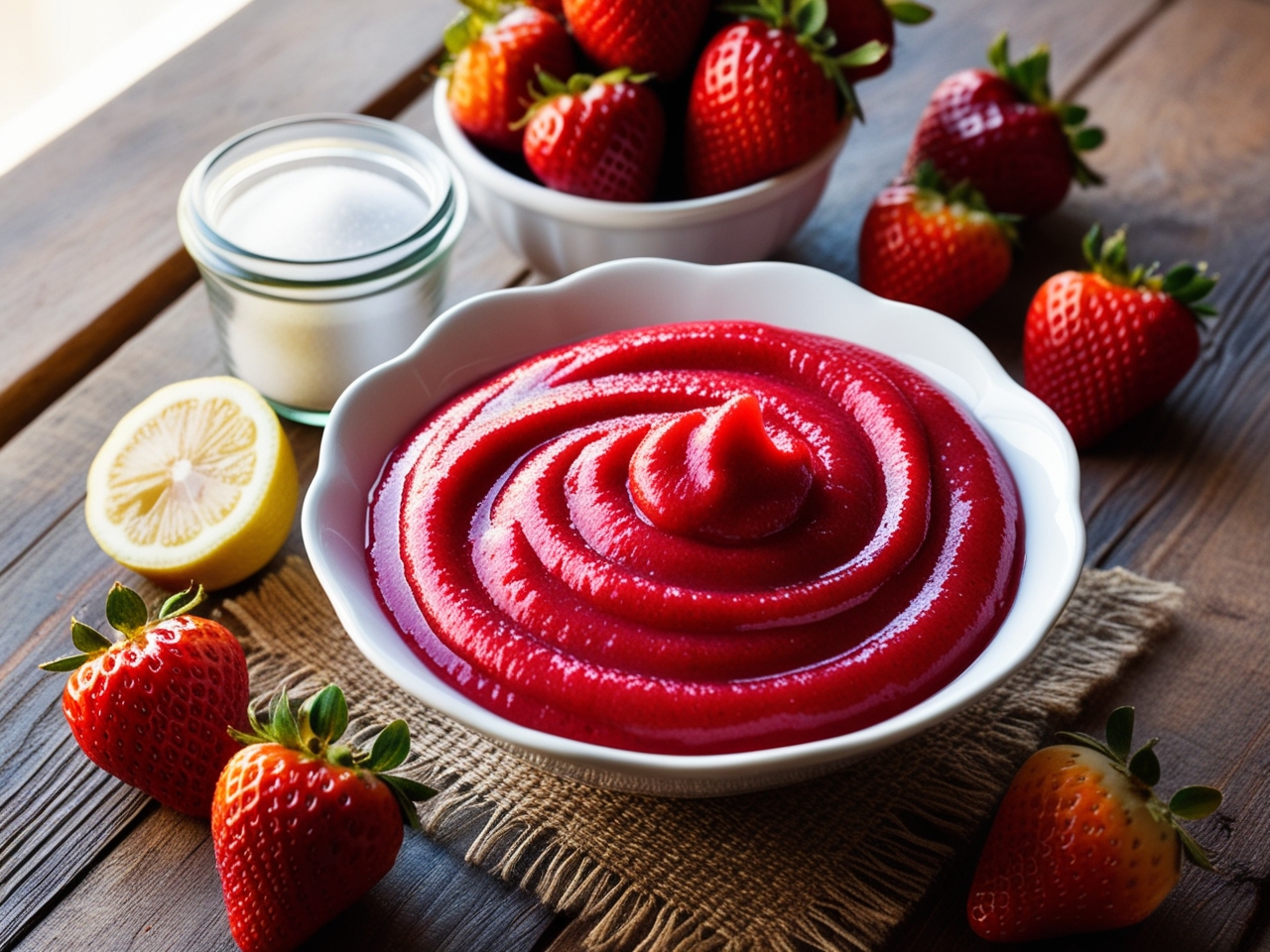Ah, the sweet, versatile delight that is strawberry puree! From elevating your desserts to adding a fresh twist to savory dishes, this kitchen staple is a must-have for both culinary pros and home cooks alike. Not only is it incredibly easy to make, but it’s also packed with nutrition, making it a treat that’s as wholesome as it is delicious.
Understanding Strawberry Puree
Definition and Characteristics
Strawberry puree is a smooth, luscious blend made by processing fresh or frozen strawberries until they reach a silky consistency. Its vibrant color, sweet aroma, and naturally tangy flavor make it a versatile ingredient for all sorts of dishes.
Unlike jams or preserves, strawberry puree retains more of the fresh fruit’s texture and essence. It isn’t just limited to desserts either—it pairs wonderfully with savory meals, breakfast staples, and refreshing drinks.
Culinary Uses
The uses of strawberry puree go beyond the obvious. Sure, it’s a phenomenal topping for pancakes, ice creams, and cheesecakes, but it also shines in recipes like smoothies, yogurt parfaits, and salad dressings. You’ll even find chefs crafting unique sauces or marinades using its natural sweetness.
Whether it’s the star of a dish or a subtle enhancer, strawberry puree brings an unmatched flair to culinary creations. As we venture deeper into this article, you’ll discover not just how to make your own puree but also creative ways to use it, from breakfast to dinner and beyond!
Health Benefits of Strawberry Puree
Nutritional Profile of Strawberries
Strawberries are tiny powerhouses of nutrition, and when transformed into strawberry puree, they retain most of their natural goodness. Packed with essential vitamins like C and K, as well as minerals such as potassium and manganese, they’re a fantastic way to boost your daily nutrient intake.
Moreover, strawberries are a rich source of dietary fiber, which supports digestion, and folate, vital for cell growth and repair. The bright red color of these berries comes from anthocyanins, powerful antioxidants that promote overall health.
Antioxidant Properties
Antioxidants are crucial for neutralizing harmful free radicals in the body, and strawberry puree is brimming with them! These antioxidants not only help slow down aging but also reduce the risk of chronic conditions like heart disease and certain cancers. The vitamin C in strawberries is especially potent, boosting the immune system and promoting healthy skin.
Health Advantages of Strawberry Puree
When you consume strawberry puree, you’re not just indulging your taste buds—you’re nurturing your body! Let’s explore some specific health benefits:
1. Digestive Health: The fiber content in strawberries aids in digestion, ensuring a healthy gut while preventing issues like constipation.
2. Heart Health: Rich in potassium and devoid of unhealthy fats, strawberry puree supports heart function and regulates blood pressure.
3. Skin and Hair Care: The combination of vitamins C and E promotes radiant skin and strengthens hair follicles, making strawberry puree a natural beauty enhancer.
4. Weight Management: Low in calories but high in flavor, strawberry puree is a guilt-free addition to meals, helping curb sweet cravings while supporting a balanced diet.
Adding strawberry puree to your routine isn’t just delicious—it’s a simple step toward better health. Let’s move forward to uncover how to make this superfood at home!
Making Strawberry Puree at Home
Selecting the Right Strawberries

Fresh vs. Frozen: Pros and Cons
Choosing between fresh and frozen strawberries depends on your needs and the season. Fresh strawberries have a more vibrant flavor and aroma, making them perfect for immediate use. However, they’re highly perishable, and their quality depends on seasonality.
Frozen strawberries, on the other hand, are picked at peak ripeness and retain their nutrients well. They’re convenient and often more affordable during the off-season. Yet, they might release excess water, slightly altering the texture of your puree.
Seasonality and Sourcing
For the best flavor, opt for fresh strawberries during peak harvest seasons, typically late spring to early summer. When shopping, look for berries that are bright red, firm, and free from blemishes. Farmers’ markets often provide locally grown options bursting with natural sweetness.
Simple Strawberry Puree Recipe
Ingredients Needed
- 2 cups of fresh or frozen strawberries
- 1-2 tablespoons of sugar (optional)
- 1 teaspoon of lemon juice
Step-by-Step Instructions
- Wash the strawberries thoroughly and remove the stems.
- If using fresh berries, pat them dry. If using frozen, thaw them slightly for easier blending.
- Place the strawberries in a blender or food processor. Add sugar if desired for sweetness and lemon juice for a zesty kick.
- Blend until the mixture is smooth. If a thinner consistency is desired, add a tablespoon of water.
- Taste and adjust the sweetness or acidity as needed.

Tips for Best Results
For a smoother texture, strain the puree through a fine-mesh sieve to remove seeds. To preserve the bright color and fresh flavor, use freshly squeezed lemon juice instead of bottled. Always taste-test as you go to ensure a balanced flavor profile.
Variations and Enhancements
Sweetened vs. Unsweetened
Sweeten your strawberry puree lightly if you’re pairing it with desserts or beverages. For savory dishes, skip the sugar to let the natural tartness shine through.
Flavor Additions
Take your puree to the next level by incorporating complementary flavors. A dash of vanilla extract or a sprinkle of cinnamon can enhance desserts. For savory or refreshing options, try adding mint, basil, or even a hint of lime zest.
Culinary Applications of Strawberry Puree
Breakfast Dishes

Pancakes and Waffles
Drizzle warm strawberry puree over fluffy pancakes or crispy waffles to create an indulgent morning treat. Its natural sweetness pairs wonderfully with whipped cream or fresh fruit.
Smoothies and Yogurt
Add a spoonful of puree to your morning smoothie for a fruity twist. Swirl it into plain yogurt to create a healthier, homemade version of fruit-flavored options available at stores.
Desserts
Cakes and Cheesecakes
Use strawberry puree as a glaze for cakes or cheesecakes to add moisture and a burst of flavor. You can also layer it between cake tiers for a delightful fruity surprise.
Ice Cream and Sorbets
Incorporate strawberry puree into homemade ice cream recipes or use it as a base for refreshing sorbets. The vibrant color and taste make it a crowd-pleaser for all ages.
Beverages
Lemonades and Teas
Mixing strawberry puree into iced teas or lemonades adds a fruity flair that’s perfect for summer. Garnish with fresh mint or a strawberry slice for a refreshing presentation.
Savory Dishes
Salad Dressings
Transform your salads with a homemade strawberry vinaigrette! Blend strawberry puree with olive oil, balsamic vinegar, and a pinch of salt for a unique dressing.
Sauces for Meats
Surprise your guests with a savory-sweet twist by using strawberry puree as a sauce for roasted chicken or grilled pork. Combine it with garlic, thyme, or black pepper for added depth.
Storage and Preservation
Refrigeration
Shelf Life
Refrigerated strawberry puree typically lasts 3-5 days when stored properly. Its freshness depends on the quality of the strawberries used and whether any preservatives, like sugar or lemon juice, were added. Homemade puree without additives tends to have a shorter shelf life than store-bought options.
Proper Containers
To ensure your puree stays fresh, use airtight containers made of glass or BPA-free plastic. Mason jars are a fantastic choice since they’re both durable and leak-proof. Always refrigerate the puree as soon as it’s prepared, and avoid frequent opening of the container to minimize exposure to air and contaminants.
Freezing Strawberry Puree
Freezing Techniques
To preserve the vibrant flavor and color of the puree, freezing is the way to go! Begin by portioning the puree into small quantities using silicone ice cube trays or freezer-safe bags. This makes it easy to defrost only what you need, reducing waste.
Label the containers with the date to track freshness—frozen puree typically maintains its quality for up to six months. For extra protection, wrap bags in aluminum foil to prevent freezer burn.
Thawing and Usage
When you’re ready to use your frozen puree, thaw it in the refrigerator overnight. If time is short, you can immerse the sealed container in lukewarm water for a quicker defrost. Stir the puree gently after thawing, as separation may occur. Whether you’re using it in drinks, desserts, or sauces, frozen puree works just as well as fresh.
Commercial Strawberry Puree
Store-Bought vs. Homemade
Quality and Taste Comparison
Homemade strawberry puree offers unmatched freshness and the ability to control ingredients, including sweetness and additives. However, store-bought puree, especially from reputable brands, is often more convenient. These products are typically pasteurized, ensuring a longer shelf life without sacrificing too much flavor.
That said, the taste of homemade puree often feels more vibrant and natural since it’s free from artificial stabilizers. On the other hand, store-bought options are an excellent backup when strawberries are out of season.
Cost Analysis
Homemade puree is generally more cost-effective, particularly if you buy strawberries in bulk or harvest them yourself. Store-bought puree can be pricier due to packaging, branding, and production costs. Depending on your time and budget, both options have their merits.
Popular Brands and Products
Market Leaders
Several well-known brands, like Bonne Maman and Smucker’s, offer high-quality strawberry puree designed for a variety of uses. They’re readily available in most grocery stores and online marketplaces.
Product Varieties
Store-bought puree comes in different forms—organic, sweetened, unsweetened, or blended with other fruits. Each variety caters to specific culinary preferences, making it easier to find the perfect match for your recipes. Whether you’re a busy home cook or a professional chef, these options save time without compromising too much on taste.
FAQs about Strawberry Puree
How can I thicken my strawberry puree?
Thickening the puree is simple and depends on your intended use. Simmer the puree over low heat, allowing the water to evaporate for a naturally thickened texture. For a quicker method, add cornstarch or tapioca starch dissolved in a bit of water to the puree while it’s cooking. Gelatin or pectin can also be used for a thicker, more jam-like consistency.
Can I use strawberry puree as a substitute for strawberry jam?
Yes, but with some adjustments! because it lacks the firm texture of jam, so it works best as a spread or topping rather than a direct substitute. Adding sugar and pectin, then cooking the puree longer, can mimic the consistency of jam if needed.
Is strawberry puree suitable for infants?
Absolutely! it is a nutritious and tasty option for infants starting on solid foods, typically around six months of age. Ensure the puree is unsweetened and smooth to avoid choking hazards. Always consult with a pediatrician before introducing new foods, especially berries, to check for potential allergies.
How do I prevent strawberry puree from becoming too watery?
Watery puree is often a result of using frozen strawberries or over-blending. To avoid this, thaw frozen strawberries thoroughly and drain any excess liquid before blending. Cooking the puree slightly after blending can also help achieve a thicker consistency.
Can I can strawberry puree for long-term storage?
Yes, you can! To can it, ensure it’s heated and properly sealed in sterilized jars using a water bath canning method. This process helps preserve the puree for up to a year. Adding a touch of lemon juice ensures safe acidity levels for longer storage.
What are some creative uses for leftover strawberry puree?
Leftover strawberry puree can be used in myriad ways! Swirl it into oatmeal, drizzle it over pancakes, or mix it with sparkling water for a refreshing drink. You can also freeze small portions in ice cube trays to use later in smoothies, sauces, or as a quick dessert topping. With its versatility, you’ll never run out of delicious ideas!
Craving a tropical twist? Discover the versatility of mango puree in our comprehensive guide: ‘Everything You Need to Know About Mango Puree‘.

